It’s time to admit it. Stanley Kubrick’s The Shining is probably the great American horror movie. At the very least, it stands shoulder-to-shoulder with Robert Wise’s The Haunting as one of the two most accomplished haunted house movies of all time, and as such it deserves its own entry in The Great Stephen King Reread. Widely dismissed when it was released, Variety, the showbiz bible, proclaimed that Kubrick had erred in “throwing 90% of King’s creation out,” that Jack Nicholson looked “idiotic,” and Shelley Duvall was “semi-retarded.” Dave Kehr at the Chicago Reader said it was “too banal to sustain interest.” Toronto’s Globe and Mail backhanded it with, “Kubrick doesn’t fail small.” Financially it was one of Kubrick’s more expensive movies, and while it made money, it pulled in less than 2001: A Space Odyssey, Full Metal Jacket, and even Eyes Wide Shut.
But over the years, people kept coming back to it. Broadcast on TV, widely available on home video, it oozed into the popular consciousness in a way no other Kubrick movie except 2001: A Space Odyssey ever did, and even then who quotes lines from 2001? It’s appeared on The Simpsons, been used in a video by Slipknot, and “All work and no play make Jack a dull boy,” “Redrum,” and “Heeeere’s Johnny!” have all entered the popular lexicon. Critical reaction has followed suit and it’s now widely regarded as a masterpiece. Perhaps the ultimate sign of pop cultural cachet, it’s the subject of numerous remixes from The Shining: Forwards and Backwards (in which two versions are superimposed over each other, one starting at the end and one at the beginning) to the family comedy version of its trailer (4 million views on YouTube and counting). So what happened? How did a pilloried critical failure turn into a part of the cultural canon? How did a moderate box office success become an acclaimed motion picture masterpiece?
It all worked out exactly as Stanley Kubrick planned.
I don’t want to write about the production history of The Shining because you can already find plenty of in-depth material online, from an exhaustive FAQ and a lengthy Wikipedia entry, to his own daughter’s documentary. Suffice it to say no one during the shoot had any clue what Kubrick was up to. Nine months of shooting, one set on fire, a pissed off Steven Spielberg and George Lucas (whose Raiders of the Lost Ark was booted from its studio dates because Stanley went over schedule), a terrorized Shelley Duvall, actors forced to repeat takes 160 times until they dissolved into tears, all unfolding on a massive indoor playset over which Kubrick had complete control.
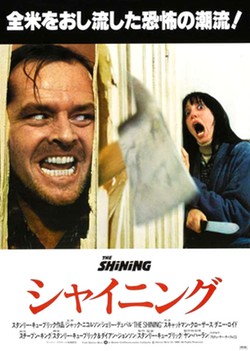 An obsessive perfectionist, Kubrick was famous for calling up theaters all over the world to dictate everything from the quality of their prints to how they were masking their screens. He once called a theater in Paris to ask why its weekly ad didn’t list one of its showtimes for his movie. This was a man who wrote a letter to projectionists (pretty common) specifying, among nine other points, that when they screened Barry Lyndon “There should be no less than 15 foot lamberts of light on the screen, and no more than 18” (not so common).
An obsessive perfectionist, Kubrick was famous for calling up theaters all over the world to dictate everything from the quality of their prints to how they were masking their screens. He once called a theater in Paris to ask why its weekly ad didn’t list one of its showtimes for his movie. This was a man who wrote a letter to projectionists (pretty common) specifying, among nine other points, that when they screened Barry Lyndon “There should be no less than 15 foot lamberts of light on the screen, and no more than 18” (not so common).
The Shining was shot completely on sets which gave Kubrick total control over the environment and he wasn’t shy about retakes in his quest for perfection. This has led critics and viewers to read intentionality into everything in The Shining. What might be dismissed as a continuity error in another movie is seen as part of Kubrick’s master plan in The Shining. And as the movie has been watched and rewatched people have found an enormous number of coincidences, secret signs, and inconsistencies in it.
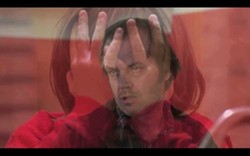 What’s it all about? Well, depending on who you talk to, it’s about the genocide of the Native Americans. Opening with a conversation about the Donner Party, then pointing out the fact that the Overlook Hotel was built on an Indian burial ground (and several Indian attacks had to be repelled during construction), the movie is saturated with images of Native American culture. There are Navajo sand paintings over the fireplace in the Colorado Lounge, the floor tiles have a Native American motif, cans of Native-American-branded Calumet baking powder are stacked in the pantry, and the elevator doors that disgorge a tidal wave of blood are exact reproductions of the lavatory doors at the Ahwahnee Hotel in California, famous for its American Indian-inspired architecture.
What’s it all about? Well, depending on who you talk to, it’s about the genocide of the Native Americans. Opening with a conversation about the Donner Party, then pointing out the fact that the Overlook Hotel was built on an Indian burial ground (and several Indian attacks had to be repelled during construction), the movie is saturated with images of Native American culture. There are Navajo sand paintings over the fireplace in the Colorado Lounge, the floor tiles have a Native American motif, cans of Native-American-branded Calumet baking powder are stacked in the pantry, and the elevator doors that disgorge a tidal wave of blood are exact reproductions of the lavatory doors at the Ahwahnee Hotel in California, famous for its American Indian-inspired architecture.
When Jack meets Lloyd, the phantasmal bartender who sets him up with ghosty drinks in the Gold Lounge, he sighs, “White man’s burdern, Lloyd my man. White man’s burden,” citing the title of Rudyard Kipling’s famous poem about the moral imperative for white Europeans to colonize “native” races for their own good. The constant references to the violent but now repressed past of the hotel could stand in for America’s attitude towards its own history, which won’t rest easy. It’s also telling that the only actual murder in the movie sees the removal of the film’s sole non-white character.
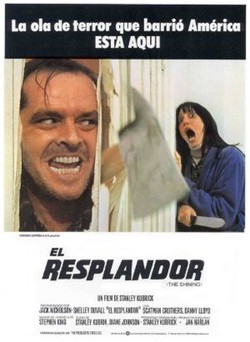 But we all know that this interpretation is a bunch of hogwash because what The Shining is really about is the Holocaust. Kubrick wanted to make a Holocaust film all his life but he could never find an angle he thought worked. He said several times that he would never want to approach the subject directly, so the oblique references in The Shining, with its images of past slaughter haunting the present, makes it feel like this is definitely Kubrick’s attempt to deal with Hitler’s genocide.
But we all know that this interpretation is a bunch of hogwash because what The Shining is really about is the Holocaust. Kubrick wanted to make a Holocaust film all his life but he could never find an angle he thought worked. He said several times that he would never want to approach the subject directly, so the oblique references in The Shining, with its images of past slaughter haunting the present, makes it feel like this is definitely Kubrick’s attempt to deal with Hitler’s genocide.
The soundtrack is awash in music by Eastern European, anti-Nazi composers like Bartók and Penderecki, and Jack Torrance writes on an Adler Eagle typewriter, a German piece of machinery, common in the 30’s and 40’s and bearing an eagle logo, the totem animal of the Third Reich. The film is fixated on the number 42 (Danny’s shirt has a number 42 on it, Wendy watches The Summer of ‘42 on TV, there are 42 vehicles in the Overlook parking lot when Jack arrives for his interview, and the car Dick Halloran rents has a 42 on the license plate) which represents 1942, the year of the Final Solution.
Which is actually not true at all because, as everyone knows, The Shining is Kubrick’s confession that he conspired with the United States government to fake the moon landing. Impressed by the innovative special effects photography in Dr. Strangelove, the government made Kubrick a deal: photograph a fake moon landing and he would never have budget worries again. A lot of the techniques that Kubrick perfected for 2001: A Space Odyssey were simultaneously developed for his fake moon landing.
But Kubrick was obviously wracked with guilt about his collusion and you can read The Shining as his coded confession. The Overlook is clearly America and Jack is the collaborator side of Kubrick’s personality, who wants to do a good job (“I signed a contract!” he screams), while Danny is Kubrick’s guilt, traumatized by seeing things he shouldn’t. In King’s novel, the previous caretaker killed his wife and daughter, but in Kubrick’s film he killed his wife and his two daughters, depicted as twins, as in Gemini, the space program before Apollo.
Then comes the visit to room 237. While wearing an Apollo 11 sweater, Danny plays on the hall carpet which looks exactly like an aerial shot of the NASA launch pads at Cape Canaveral. He is drawn to room 237 (217 in the book—changed because the distance from the Earth to the Moon is approximately 237,000 miles) and opens the door where he sees something horrible and rotten. He’s so traumatized that he’s unable to speak about what he’s witnessed. Later, when Jack explores the same room, he’s beguiled by the sexy lady on offer but flees when he realizes she’s actually a rotten corpse, then denies there was anything in the room at all.
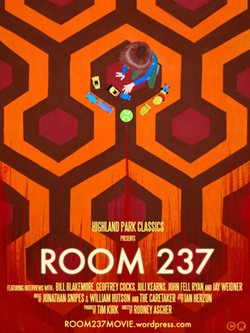 Are any of these wild theories actually true? They all are (and if you want to hear more of them, check out the great documentary, Room 237). The Shining contains enough inconsistencies to make a case for all of them. For a movie as tightly controlled as The Shining, why is it full of things that don’t add up? Why is the previous butler called Charles Grady in one scene and Delbert Grady in another? Why is Jack Nicholson reading Playgirl in the lobby of the Overlook Hotel on closing day? Does the hotel leave copies lying around for their guests?
Are any of these wild theories actually true? They all are (and if you want to hear more of them, check out the great documentary, Room 237). The Shining contains enough inconsistencies to make a case for all of them. For a movie as tightly controlled as The Shining, why is it full of things that don’t add up? Why is the previous butler called Charles Grady in one scene and Delbert Grady in another? Why is Jack Nicholson reading Playgirl in the lobby of the Overlook Hotel on closing day? Does the hotel leave copies lying around for their guests?
Chairs in the background disappear from shot to shot. You could say the camera crew were tired that day, but a closer examination of the Overlook Hotel set reveals that its architecture doesn’t add up. Windows are placed on walls that can’t possibly contain windows, doors are placed on walls that can’t logically contain doors. (See this YouTube video for a breakdown of the Overlook’s impossible architecture)
On the one hand, some things that people project onto The Shining have logical explanations. The brief scene of the man in a dog costume on his knees in front of a partygoer has been explained as everything from Jack Torrance’s repressed homosexuality to commentary on U.S./Soviet relations. If you’ve read the book, however, you know that this is Roger, a spectral partygoer from the Overlook’s past who gets a great deal of page time. Kubrick has also explicitly said that the photo at the end of the movie indicates that Jack Torrance is a reincarnated version of an earlier hotel official. But what about all the other loose threads? (Even Roger Ebert is driven nuts by them.)
 Here’s my theory. People close to Kubrick report that he was bored after Barry Lyndon and looking for new challenges. He was also closely following research being done by marketing and advertising agencies regarding subliminal imagery and human perception, and he had long been interested in Freud and his theories of the uncanny. So, to entertain himself, he decided to make his own TARDIS: a movie that is bigger on the inside than it is on the outside.
Here’s my theory. People close to Kubrick report that he was bored after Barry Lyndon and looking for new challenges. He was also closely following research being done by marketing and advertising agencies regarding subliminal imagery and human perception, and he had long been interested in Freud and his theories of the uncanny. So, to entertain himself, he decided to make his own TARDIS: a movie that is bigger on the inside than it is on the outside.
The Shining seems to be three things on its surface: the story of a haunted hotel, an adaptation of a best-selling horror novel, and the new movie from a much-lauded director. But that camouflages what’s happening inside, which is that Kubrick is building the ultimate haunted house, one that’s portable and made of light, capable of appearing anywhere there are projectors and screens.
?Following his thesis that the movie is about three people going quietly insane together, Kubrick does everything he can to undermine our perceptions and call them into question, from making sure the architecture doesn’t add up, to making sure the narrative doesn’t add up. The inconsistencies are intentionally designed to keep the viewer slightly off balance, and thinking about them too hard leads one down a rabbit hole. Kubrick was probably aware of the rumors about himself and the moon landing (a movie, Capricorn One, about the fake landings came out around the same time he was in pre-production on The Shining), he was also deeply interested in genocide and history. James Joyce once famously said about his book Ulysses, “I’ve put in so many enigmas and puzzles that it will keep the professors busy for centuries arguing over what I meant, and that’s the only way of ensuring one’s immortality.” Kubrick may have felt the same way. He loved chess, he loved puzzles, he loved riddles, and so The Shining was his ultimate riddle, wrapped in a mystery, wrapped in a hedge maze.
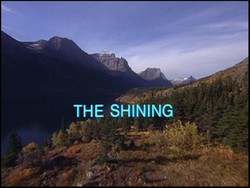 Why? Because it was fun. Numerous crew members report that the maze set for The Shining had movable walls and that while Kubrick supplied the crew with maps, he would occasionally change the layout. He communicated with the set via a system of mics and speakers, and when a crew member would get lost they’d cry out for help and hear the disembodied voice of Stanley Kubrick laughing back at them. He’s doing the same thing today, years later. He’s left us just enough string to get well and truly lost in the 35mm maze he built and now he’s laughing. But I like to think it’s not at us, but with us. Because everyone loves a haunted house as long as they know there’s an exit, and Kubrick has helpfully provided us with one. It comes at 114 minutes, when the end credits roll.
Why? Because it was fun. Numerous crew members report that the maze set for The Shining had movable walls and that while Kubrick supplied the crew with maps, he would occasionally change the layout. He communicated with the set via a system of mics and speakers, and when a crew member would get lost they’d cry out for help and hear the disembodied voice of Stanley Kubrick laughing back at them. He’s doing the same thing today, years later. He’s left us just enough string to get well and truly lost in the 35mm maze he built and now he’s laughing. But I like to think it’s not at us, but with us. Because everyone loves a haunted house as long as they know there’s an exit, and Kubrick has helpfully provided us with one. It comes at 114 minutes, when the end credits roll.
Grady Hendrix has written about pop culture for rags ranging from Playboy to World Literature Today. He also writes books! You can follow every little move he makes over at his blog.










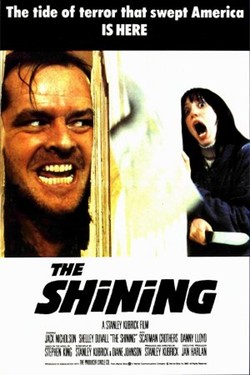
Horrible movie. I saw it at the theater with a date and it was Nicholson at his worst with huge amounts of overacting. Shelly Duvall wasn’t much better.
As much as I love the book and anxiously await the sequel to it, I never thought much of this movie. I saw it for the first time right around the same time the USA TV version with the guy from Wings played Jack and thought the latter was superior even with the cheesy effects. I haven’t seen the TV version since, so my opinion may not be valid 10 years later.
The one thing that I feel Kubrick missed a big opportunity in was excluding the hedge animals. Those things were AWESOME in the book and TV movie. I’m relatviely new to the Doctor Who universe, but I am pretty certain King’s hedge animals were the inspiration for the Weeping Angels.
Kubrick’s film is just too brash and loud for me, despite all the supposed hidden subtelty. I guess I’m too simple.
“‘Heeeere’s Johnny!…entered the popular lexicon.”
Um, I think the Tonight Show might share some of the credit for that one.
@2,
To be fair, I think if Kubrick had tried to do the hedge animals coming to life with ’70s special effects, it would probably have been hilariously bad and killed the mood he was trying to create.
On the other hand, if he hadn’t done them coming to life but just had them sit there and be creepy, that might have worked.
who quotes lines from 2001?
I’m sorry, Dave, I’m afraid I can’t do that.
I absolutely love the movie! It’s pretty weird…..I like weird. Nicholson is his maniacal best. Read the book too, vey nice….but the movie is my favorite.
Wow – this is the first I’ve ever heard that _The Shining_ wasn’t universally loved (except by Stephen King – I knew that bit.) I’d just always assumed the consensus was that it was a modern classic.
The documentary _Room 237_ sounds a hoot.
I’ve been wondering the past year or so, exactly when it was that this movie became “a beloved classic.” I was there opening weekend. I remember the disappointment. It wasn’t just the critics, it was all of us King fans. Nicholson? Miscast. Danny’s fugues? Hilarious. Shelly Duvall? Ridiculous. Great swaths of the movie drag, the “horror” stuff is stupid, the ending I don’t know what even.
Teapot7, believe it. The Shining was almost universally regarded as a great example of how NOT to adapt a novel until at least the turn of the century. Contributed HEAVILY to the feeling in the late ’70s and early ’80s that, after Carrie, no one would ever make a good movie out of a Stephen King story. Until Stand By Me, of course.
So, in summary: pee-yew. Bad movie. I don’t think I’ll ever understand how things changed.
I’d encourage people who were disappointed by the movie to give it another try. Try to ignore the Stephen King novel it’s based on because it’s a pretty stunning achievement on its own terms. I think history is bearing that out as the critical re-evaluation has been massive, and the way it’s infiltrated pop culture is impressive.
Watching Room 237 you’ll see that a lot of the people the documentary interviews had the same initial negative reaction but the movie got under their skin and they found themselves returning to it over and over again. I felt the same way. I saw it when I was really young and was terrified. Then I watched it as a college student who felt like it was my duty to have an Important Definitive Opinion about everything and found it pretty blah. But as an adult I keep going back to it.
It’s definitely one of those movies that has stood the test of time.
visually the movie is very compelling.
the story? well I prefer the book but I can see the movie as separate.
It is good to showcase the movie as a connected but separate thing and I appreciate that the writer of the Stephen King re-read chose to do this.
As for “laughing with us” I doubt it. Kubrick was more of a “laughing at you” kind of guy.
How hilarious, to read a group of people dismissing one of the all-time great film masterpieces because “the ending I don’t know what even” or because Nicholson — who, notably, spends most of the movie with almost no affect at all — is “overacting.” I love the internet.
I think this movie’s greatness has been greatly skewed by the amount of cinephiles who believe every crap Stanley Kubrick took was a masterpiece. While I think Kubrick was a genius, that doesn’t change the fact that his version of The Shining falls short, and not just because of the changes made to the book. There are certainly good things about it, but to say it’s one of the greatest American horror movies is a bit of an overstatement.
Kubrick treated these characters with such a cold eye, that it took away any sympathy. Nicholson is a monster that you know is going to kill somebody from the first minute you see him. I have no idea what Shelly Duvall was doing in this movie. Everyone is just going through the motions waiting for the last act to start so they can scream and swing axes. The only saving grace, is that the film is so well-made technically that these things can be somewhat forgiven.
Even if King’s novel weren’t a masterpiece in my opinion, the film would still not work. A story about a family collapsing needs to have a family that seems to care about this collapsing. Instead these people are either one-dimensional monsters (Jack) or dead-eyed zombies (Shelly/Wendy). Who cares if the haunted hotel gets these people? They were hopeless to begin with.
Wait a minute. 42=Final Soultion? You don’t think Douglas Adams was referring…nah.
I remember the film as being quite brilliant the first time I watched it some years ago as an adolescent. ‘All work and no play..’ and ‘REDRUM’ were both moments in the film that totally worked with me. The twins, elevator and Jack frozen in the snow, likewise superb.
I read the book recently and was disappointed. I’m a big Stephen King fan and I felt it didn’t live up to much of his other works. I had expected it to be far better than it is. It’s still a writer finding his way, with flashes of the future King.
So then I watched the movie again recently and guess what. It doesn’t live up to my memory of it as a classic at all. Much of the dialogue at the start is painfully badly acted Nicholson really doesn’t ‘shine’ until later in the movie and Shelly Duvall is uterly hopeless at first, but she is brilliant when challenged by Jack. It’s like two completely different movies bolted together made by different directors. The point at which it changes, for both actors and the film in general, is the scene in Jack’s writing room, where he tells Wendy to stay out while he’s in there.
All told I’m consistently perplexed by it. A film that I both love and am frustrated by.
I’d read the book several times before the movie came out. I was, like most, astonished at the changes Kubrick had made. But I knew as I watched it that it was monumentally wonderful. I didn’t care in the least that it wasn’t the same story as in the novel. Now we had TWO great works of art to enjoy. I was never aware of any of the conflicting theories you describe. I’m going to enjoy reading up on those.
I don’t know how common my attitude is: Love the book AND the movie. I don’t know why people have to get so torqued when a movie isn’t precisely exactly the same as a book.
A new theory: with Reagan coming in, the themes of this film, namely the nuclear family structure as inherently repressed, toxic, and in denial of abuse stemming from sexual puritanism, all the way through the larger themes of American capitalism and the hotel as the haunted and eternal container of all the evil committed in the name of that false ideal, could not find full fruition in the incoming conservative political climate, which doomed Kubrick to bury his frustrations onto the actors, causing confusion and harm to the overall underlying message and tone of the film, and doomed it to failure.
The Golden Rey of it’s truths was tarnished in production by forces beyond even Kubrick’s fastidious control.
I just don’t like Stanley Kubrick movies. I WANT to because everybody fawns all over Kubrick going “genius genius” bit outside of little snippets, taken as a whole, his movies are just unwatchable to me. It’s NOT just the shining. If it was I could just chalk it up to me being unhappy with his interpretation of a novel that I liked. All his movies are garbage in my mind. I didn’t enjoy a single one. They don’t make me think, and that’s ok, a lot of movies don’t make me think…but they don’t entertain me either and that’s an unforgivable sin.
If you find them “unwatchable,” you may want to try watching them differently.
Certain People loved the movie because they never read the book. Not all people. But where the book had characters that you could sympathies with and then care about when bad things start happening. The movie starts with an insane Jack and ends with the same insane Jack. He was going to try to kill his family even if he made plenty of money and lived in the suburbs.. The book is scary and builds to an exciting climax, suspenseful, frightening. The Movie just stops. Kubrick need the Title for commercial reasons. He could have written a very similar movie with a haunted hotel but with King’s name even less people would have gone to see it. But Kubrick does not believe in story arcs and a plot. A bunch of things happen and then it stops.
For sure: both Nicholson and Duvall give one-note performances. You never buy into them as a couple, let alone as the parents of a small child. I still think it’s a great movie though, and found the book (which I read subsequently) a bit underwhelming. I mean, predatory topiary?